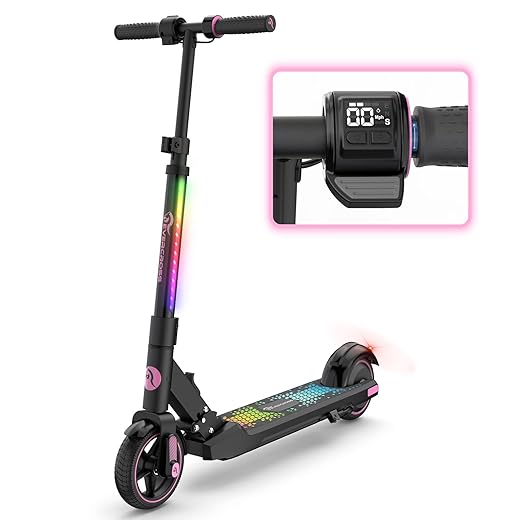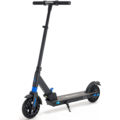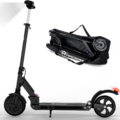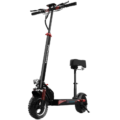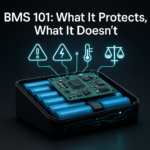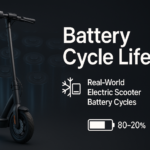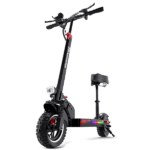- Home
- Scooters
- Electric Scooters
- EVERCROSS EV06C
EVERCROSS EV06C
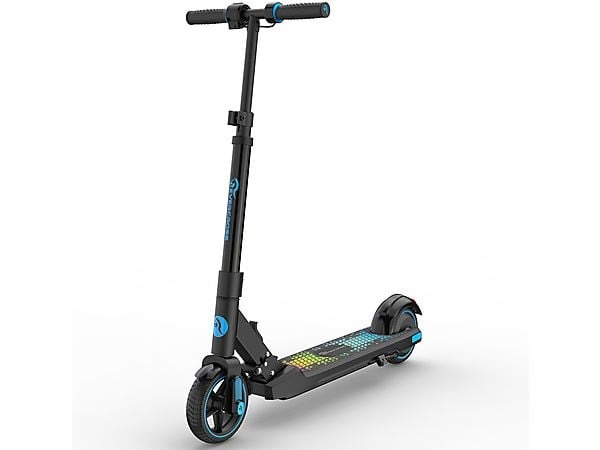

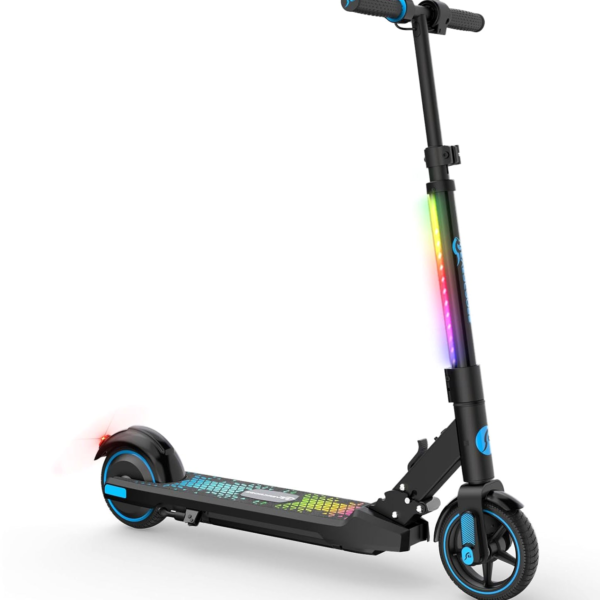
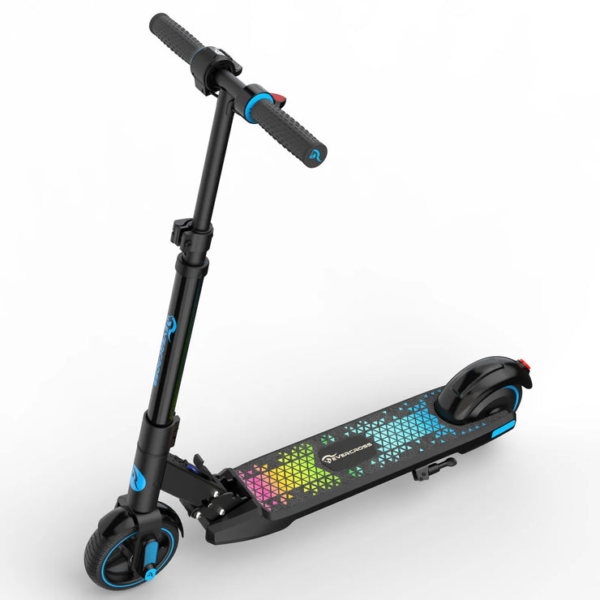
- Battery Range: 5.0 miles (8.0 km)
- Top Speed: 9.3 mph (15 km/h)
- Motor Power: 150 W
- Weight Capacity: 132 lb (60 kg)
- Charging Time: ~3 h
- Scooter Weight: 22.3 lb (10.1 kg)
PROS
- 3 speed modes for kids
- LED display with battery/speed
- Lightweight at 22.3 lb (10.1 kg)
- Colorful deck/stem lighting
- Simple rear foot brake
CONS
- Short 5 mile (8 km) range
- No suspension
- IP rating not specified
Table of contents
- What Is the EVERCROSS EV06C?
- How the EVERCROSS EV06C Works
- Key Specifications
- Design & Build Quality
- Performance Fundamentals
- Battery, Range & Efficiency
- Ride Quality & Comfort
- Braking & Safety Features
- Portability & Daily Usability
- Maintenance & Care
- Weather & Seasonal Considerations
- EVERCROSS EV06C vs Alternatives
- Who the EVERCROSS EV06C Is (and Isn’t) For
- FAQs
- Glossary
- Final Thoughts
The EVERCROSS EV06C is a compact, foldable kids’ electric scooter built for supervised fun on smooth paths. It blends gentle power, clear controls, and simple care so young riders can learn safely. Because its pace is capped and the cockpit is straightforward, parents gain confidence while kids build skills at their own speed. Moreover, its lightweight frame and calm throttle response make first rides feel predictable.
Additionally, if you’re comparing first-ride options, take a look at the Hover-1 My First E-Scooter.
What Is the EVERCROSS EV06C?
The EVERCROSS EV06C is a children’s e-scooter with a 150 W rear hub motor, a 25.2 V 2.5 Ah battery, and three speed modes. It’s intended for roughly ages 6–12 and a maximum load of 60 kg (132 lb). Moreover, it rolls on 6.5-inch solid tires, folds quickly, and uses a thumb throttle with a clear LED display. A rear fender brake and an electronic brake deliver predictable stopping. Consequently, the scooter emphasizes controlled starts, calm acceleration, and easy-to-read indicators.
Because it is light and compact, the EV06C fits short neighborhood rides, school-yard loops, and smooth bikeway practice. However, it is not designed for commuting or rough surfaces. Most importantly, it requires a short kick before the motor engages, which helps prevent unintended launches and builds a safe habit. Additionally, the capped top speed keeps energy use low and range more consistent.
How the EVERCROSS EV06C Works
Motor & Controller. A 150 W brushless hub motor sits in the rear wheel. The controller meters output in three modes, each capping speed and smoothing throttle input. In effect, it feels like riding a bike with three preset gears; however, the electronics manage the limits for you. Therefore, power delivery stays steady as skills improve.
Battery & Power Delivery. A 25.2 V, 2.5 Ah lithium-ion pack (about 63 Wh) supplies energy to the controller, which then feeds the motor. Because electrical draw rises with speed, lower modes stretch ride time and keep heat in check. Thus, kids can practice longer without frequent charging. Furthermore, the compact pack keeps weight down, which helps stability at kid speeds.
Throttle & Kick-to-Start. A thumb lever signals the controller. Nevertheless, the motor only activates once the scooter is rolling around 5 km/h (3 mph). Therefore, a small kickoff is required, which reinforces safe starting habits and reduces surprises. As a result, first launches feel deliberate rather than abrupt.
Brakes. The EV06C pairs an electronic brake with a rear foot fender brake. The electronic system slows the motor electrically, while the fender adds simple mechanical stopping. Together, they produce a calm, firm feel that suits beginner speeds. Additionally, the two-method setup teaches kids a clear braking routine.
Lights & Display. A compact LED readout shows speed, mode, and battery. Additionally, decorative LEDs on the stem and deck improve conspicuity and add a playful touch without distracting the rider. Still, parents should treat them as supplementary rather than primary lights.
Key Specifications
To keep scanning easy, the specifications are grouped into simple blocks.
General
| Item | Detail |
|---|---|
| Model | EVERCROSS EV06C (kids electric scooter) |
| Recommended rider age | ~6–12 years |
| Max rider weight | 60 kg (132 lb) |
| Tires | 6.5 in solid, puncture-proof |
| Frame | Folding stem, kid-sized cockpit |
Performance & Power
| Item | Detail |
|---|---|
| Motor | 150 W rear hub (brushless) |
| Top speed | 15 km/h (9.3 mph) |
| Speed modes | 5 / 10 / 15 km/h (3 / 6 / 9.3 mph) |
| Hill guidance | Gentle neighborhood grades (~8–10°) |
| Start behavior | Kick-to-start (no zero-start) |
Battery, Charging & Electrical
| Item | Detail |
|---|---|
| Battery | 25.2 V, 2.5 Ah (≈63 Wh) |
| Charger | 29.4 V, 1.0 A |
| Typical charge time | About 3 hours |
| Claimed range | Up to 8 km (≈5 mi) |
| Display | LED (speed/mode/battery) |
| Lighting | Decorative stem/deck LEDs |
Build & Dimensions (including folded)
| Item | Detail |
|---|---|
| Net weight | ≈10.1 kg (22.3 lb) |
| Unfolded (L×W×H) | 78–96 × 39 × 78 cm ≈ 30.7–37.8 × 15.4 × 30.7 in |
| Folded (L×W×H) | 79 × 39 × 30 cm ≈ 31.1 × 15.4 × 11.8 in |
| Handlebar height range | ~74–94 cm (29–37 in) |
| Deck | Low stance, kid-friendly width |
Safety & Control
| Item | Detail |
|---|---|
| Brakes | Electronic + rear fender foot brake |
| Start logic | Kick-to-start |
| Visibility | LED indicators, stem/deck lighting |
| Water exposure | No stated IP rating; avoid wet use |
Features & Extras
| Item | Detail |
|---|---|
| Speed limiting | Three modes (parent-friendly) |
| Controls | Thumb throttle + LED display |
| Folding | One-step fold |
| Tires | Solid (low upkeep) |
| Connectivity | App features may vary by region; core functions onboard |
Warranty & Compliance
| Item | Detail |
|---|---|
| Electrical safety | Product line indicates UL 2272 compliance |
| Warranty | Limited coverage; terms vary by region |
| Intended use | Recreational riding on smooth, dry surfaces |
Note: Real-world results vary with rider mass, terrain, temperature, and chosen mode. Therefore, supervise young riders and use a well-fitting helmet.
Design & Build Quality
The frame is compact, sturdy, and sized for smaller riders. Because the stem folds with a simple latch, parents can stow the scooter in a trunk or closet without effort. Additionally, the low deck lowers the center of gravity, which improves balance at slow speeds and simplifies stepping on or off. As a result, first sessions feel calm rather than wobbly, and stance changes feel natural.
The cockpit favors clarity. The thumb throttle sits close to the right grip, and the LED panel is readable in daylight. Meanwhile, small-diameter grips suit young hands and limit fatigue. The rear fender is reinforced, so it responds predictably when pressed during braking. Moreover, tidy cable routing keeps edges snag-free.
Fit and finish are tidy. Cables are routed cleanly, and the deck panels sit flush. Solid tires eliminate inflations and punctures, which reduces maintenance. However, they ride firmer than air-filled tires, so the EV06C rewards smooth pavement. Consequently, planning routes on clean, even surfaces pays off in comfort.
Performance Fundamentals
Takeoff & Acceleration. The scooter rolls with a quick kick; then the motor adds a measured push. In the lowest mode, acceleration is gentle and steady. In the middle mode, the pull is stronger but still controlled. In top mode, it climbs to 15 km/h (9.3 mph) without surging. Consequently, new riders can focus on steering and stance instead of managing abrupt power. Furthermore, the steady ramp helps balance stay centered.
Cruising Stability. The short wheelbase and low deck create reassuring stability at kid speeds. On clean asphalt, the scooter tracks straight and resists bar wobble. Additionally, a slight knee bend over seams helps it stay settled, which boosts confidence during longer runs. Therefore, practice laps feel smooth and repeatable.
Hill Behavior. On gentle neighborhood grades (~8–10°), the EV06C slows yet keeps moving, especially if the rider adds an occasional kick. However, long or steep hills exceed its design intent. Therefore, route planning matters; choosing flatter paths preserves pace and battery. Likewise, staying in the middle mode often maintains momentum better than toggling top speed.
Noise & Vibration. The hub motor hums softly. Solid tires transmit surface texture, but the scooter’s low mass and capped speed keep vibration in check on smooth ground. Thus, comfort remains reasonable for short play sessions. Even so, rough patches feel busier than they would on pneumatic tires.
Battery, Range & Efficiency
Capacity & Right-Sizing. The 25.2 V, 2.5 Ah pack stores about 63 Wh, which suits the EV06C’s speed and weight. Because power demand rises quickly with speed, the middle mode often yields the best balance between fun and distance. Moreover, gentler starts reduce current spikes and heat.
Rated vs. Real-World Range. The listed range is up to 8 km (≈5 mi). Light riders, flat terrain, and steady cruising lengthen rides. Conversely, frequent stops, cold weather, hills, and top-mode usage shorten them. Even so, the decorative LEDs draw very little compared with the motor, so rider input and terrain matter more. Consequently, smooth pacing usually beats short bursts.
Charging Habits. A full charge takes roughly three hours. After rides, a brief top-up keeps the pack ready. Avoid deep discharges. Furthermore, once the indicator shows full, unplug the charger and close the port. If you’ll store the scooter, aim for 50–80% charge and refresh monthly. Meanwhile, keep the charger off hot surfaces.
Temperature Effects. Lithium-ion cells prefer moderate temperatures. In the cold, voltage sag increases, and range drops. In heat, protective limits may appear sooner. Therefore, let the scooter acclimate to ambient conditions before spirited use, and avoid charging when it’s very hot or very cold. Additionally, never charge in direct sun.
Ride Quality & Comfort
Tire Character. Solid 6.5-inch tires are puncture-proof and maintenance-light. However, they ride firmer than pneumatic tires. Consequently, the EV06C feels best on smooth concrete or fine asphalt. Cracks, cobbles, and gravelly edges feel busy, so route choice matters. Therefore, plan rides where surfaces are even and clean.
Ergonomics. The adjustable handlebar helps across ages and heights. Younger kids keep it lower for stability. Older kids raise it to avoid hunching. Additionally, the thumb throttle requires little effort, which reduces hand strain. As a result, longer practice windows stay comfortable.
Frame Feel & Flex. At the EV06C’s capped speed, the stem feels acceptably stiff. Side-to-side flex is minor in normal use, so steering feels precise for a kids’ platform. Because the deck is low, weight shifts and foot repositioning remain easy, which encourages better balance. Moreover, the compact mass keeps quick corrections light.
Surface Choice. Smooth, dry paths are ideal. Wet, broken, or loose surfaces undermine traction and control. Therefore, plan sessions for friendly terrain to build consistent habits quickly. Likewise, sweeping wide lines through turns keeps speed in check and confidence high.
Braking & Safety Features
Brake System. Electronic braking slows the motor rapidly yet gently, while the rear fender provides mechanical bite when pressed. Together, they shorten stopping distances at modest speeds and provide redundancy. As a result, kids learn a simple two-stage routine: ease off the throttle, then step the fender if needed. Additionally, practicing straight-line stops reduces skids.
Start Logic & Modes. Kick-to-start logic requires motion before the motor engages. This design reduces accidental takeoffs if the throttle is bumped. Meanwhile, three speed modes let parents match pace to skill and environment. Consequently, families can raise limits as confidence grows.
Lights & Visibility. Stem and deck LEDs increase conspicuity near dusk and in shaded areas. Nevertheless, treat them as supplemental; high-visibility clothing and supervision matter more. Therefore, daytime use on clear paths remains the safer choice. Still, checking that LEDs function before rides helps others notice the scooter.
Water & Weather. No IP rating is stated. Consequently, avoid rain, puddles, and wet surfaces. Moisture can reduce traction and risk electronic issues, so dry conditions are the rule. Furthermore, wipe the scooter dry if it encounters splashes.
Certification Notes. The product line indicates UL 2272 compliance for electrical safety. Even so, a helmet is essential, and closed-toe shoes improve grip. Local rules vary by region, so ride where small, slow devices are permitted. Additionally, supervised practice sessions shorten the learning curve.
Portability & Daily Usability
Weight & Carrying. At about 10.1 kg (22.3 lb), the scooter is manageable for adults and older kids. Additionally, the folded footprint fits most trunks and hallway corners, which simplifies school runs and weekend outings. Consequently, storage rarely requires rearranging a closet.
Folding Mechanism. The one-step latch makes folding fast: release, lower, and lock. After unfolding, listen for a positive click and check the safety tab. Consequently, the stem stays secure, and the ride feels solid. Moreover, teaching a short fold/unfold checklist helps kids remember the sequence.
Storage. Store indoors, away from heat and moisture. A hook, shelf, or small stand keeps scuffs off the deck. If space is tight, the ~30 cm (≈12 in) folded height helps the scooter tuck under a bench or onto a utility shelf. Meanwhile, avoid resting heavy items on the folded stem.
Security Habits. Supervised sessions rarely need locks. If you must step away briefly, a light cable through the frame deters quick grabs. However, do not leave the scooter outside in the rain or direct sun, and avoid overnight outdoor storage. Likewise, label the charger to prevent mix-ups.
Maintenance & Care
A short routine keeps the EV06C consistent and safe.
Before Each Ride
- Verify the folding latch is fully seated.
- Confirm the electronic brake responds and the rear fender moves freely.
- Inspect tires for embedded debris or cuts.
- Check the battery level on the display.
- Briefly wiggle the bar to confirm no play.
Weekly
- Wipe dust and grit with a damp cloth.
- Check fasteners at the stem clamp, handlebar, and deck.
- Ensure throttle returns smoothly and the display reads clearly.
- Review mode settings to match the riding area.
Monthly
- Inspect the wire runs along the stem and under the deck for chafing.
- Charge to full, observe the charger indicator, then unplug.
- Revisit speed-mode limits and match them to current skill.
- Lightly tighten any hardware that has settled.
After Wet Exposure
- Although wet riding is discouraged, if splashes occur, power off, towel dry, and allow several hours of indoor air-drying before the next ride. Additionally, recheck the brake response afterward.
Storage
- For multi-week breaks, store at ~50–80% charge.
- Refresh monthly.
- Keep the scooter in a cool, dry place; extreme heat or freezing shortens battery life. Consequently, climate-controlled storage is preferable.
Weather & Seasonal Considerations
Dry, Mild Conditions Are Best. The EV06C is tuned for smooth, dry pavement. As temperatures drop, range decreases. As temperatures rise, electronics may limit output to protect components. Therefore, schedule shorter sessions during temperature extremes and plan a cool-down between runs.
Avoid Rain. With no stated IP rating, puddles and showers are off-limits. Wet surfaces lengthen braking and cut traction. Thus, wait for dry ground, and inspect the deck and tires afterward. Additionally, clean grit from the fender area to preserve brake feel.
Cold Weather Tips. If riding on cold days, warm the scooter indoors first. Expect softer acceleration and lower range. Additionally, let the pack reach room temperature before charging post-ride. Consequently, battery health stays stronger.
Hot Weather Tips. In high heat, give the scooter short cooldowns between runs. Never charge in direct sunlight or inside a hot vehicle. Likewise, keep the charger off hot surfaces to protect its components. Meanwhile, store away from windows and heaters.
EVERCROSS EV06C vs Alternatives
Versus Commuter Scooters. Adult commuters add speed, weight, and larger batteries. They deliver range, yet they demand more skill and maintenance. By contrast, the EV06C keeps power modest, which is safer for beginners and simpler for families. Consequently, practice remains calm and approachable.
For a hands-on perspective on another entry-level kids model, check our Hover-1 My First E-Scooter review.
Versus Performance Models. Performance scooters prioritize acceleration and top speed, which do not suit children. They often add pneumatic tires, hydraulic brakes, and heavy frames. Consequently, they are overbuilt for a learner. The EV06C’s light weight and limited pace make practice less intimidating. Moreover, storage and carry are easier.
Versus Off-Road Scooters. Off-road models use knobby tires and high-torque drivetrains for dirt. They feel heavy and twitchy for kids. Meanwhile, the EV06C is happiest on smooth pavement, where stability and low deck height keep learning stress-free. Therefore, it better fits neighborhood play.
When the EV06C Excels. It shines as a supervised first e-scooter: short rides, flat routes, and controlled speeds. Parents can cap pace, and storage is easy. Therefore, it fits households that value predictability over raw power. Additionally, the low deck makes balancing simpler.
When to Consider Something Else. If you need longer range, higher speed, or all-weather use, consider a larger platform once the rider is older and experienced. Bigger batteries, pneumatic tires, and higher water protection suit those goals, albeit with more upkeep. Still, the EV06C remains an excellent starting point.
Who the EVERCROSS EV06C Is (and Isn’t) For
Ideal For
- Families seeking a first e-scooter for kids ~6–12
- Riders practicing on smooth, dry, supervised paths
- Households that want light weight and quick storage
- Parents who prefer kick-to-start logic and capped speed modes
Not Ideal For
- Daily commuting or long point-to-point trips
- Wet, icy, or broken surfaces
- Steep hills or extended climbs
- Unsupervised use by very young or inexperienced riders
Because the EVERCROSS EV06C prioritizes calm power delivery, low deck height, and clear controls, it supports steady skill building. Additionally, its simple fold and small footprint make daily handling painless. Ultimately, it helps families introduce powered riding in a measured way.
FAQs
1) How fast does the EVERCROSS EV06C go?
Top speed is about 15 km/h (9.3 mph). Lower modes cap pace at roughly 5 km/h and 10 km/h, respectively. Consequently, beginners can progress gradually.
2) What range should we expect?
Plan for up to about 8 km (≈5 mi) under easy conditions. Terrain, temperature, stops, and rider mass all influence distance; therefore, treat that figure as guidance.
3) Does it use zero-start throttle?
No. It’s kick-to-start; the scooter must roll around 5 km/h (3 mph) before the motor engages. As a result, unintended launches are less likely.
4) Is it water-resistant?
No IP rating is stated. Therefore, avoid rain and puddles to protect components and keep traction consistent.
5) What brakes are fitted?
An electronic brake plus a rear fender foot brake. Together, they provide steady, predictable deceleration for child speeds. Additionally, practicing straight-line stops helps.
6) How long does charging take?
About three hours from low to full with the included 29.4 V, 1.0 A charger. Consequently, quick top-ups after short sessions are easy.
7) What does this EVERCROSS EV06C overview cover that helps parents decide?
It highlights speed caps, kick-to-start logic, light weight, and low-maintenance tires, which together make supervision simpler and practice safer. Moreover, it explains real-world range factors clearly.
Glossary
Ah (Amp-hour). Battery capacity over time; e.g., 2.5 Ah can supply 2.5 A for one hour.
Wh (Watt-hour). Energy capacity; Wh = V × Ah (≈63 Wh here).
Controller. The unit that regulates battery power to the motor.
Hub motor. A motor built into the wheel hub; compact and low-maintenance.
Kick-to-start. A safety feature that requires motion before the motor activates.
Regen (electronic braking). Electrical slowing of the wheel via the motor.
Rear fender brake. Foot-operated mechanical brake acting on the rear wheel.
Top speed. Highest speed achievable in ideal conditions.
Deck. The platform for your feet.
Stem. The tube connecting the deck to the handlebar.
Stem flex. Side movement in the stem; less flex improves stability.
UL 2272. Electrical system safety standard for small e-mobility devices.
IP rating. Dust/water ingress scale; none is stated for this model.
Solid tire. Puncture-proof, airless tire; durable yet firmer-riding.
Cutoff. Electronic limit that caps speed or power to protect components.
Speed mode. Preset that limits maximum speed and softens throttle response.
Final Thoughts
The EVERCROSS EV06C delivers what a first kids’ scooter should: gentle power, guarded speed, and straightforward care. The kick-to-start logic reduces surprises, while three modes let parents tailor pace as skills progress. Solid tires minimize upkeep, though they ride firmer than pneumatic options. Because no water rating is stated, dry-day sessions on smooth paths are the smart choice.
Daily handling is also easy. The fold is quick, the package is small, and the weight is manageable for adults. Meanwhile, a short maintenance routine—fastener checks, wipe-downs, and sensible charging—keeps performance consistent. As confidence grows, families can raise the mode and gradually extend ride time. Ultimately, the EV06C makes powered riding approachable without overwhelming young riders or caretakers. Consequently, it’s a sensible first step into e-mobility for kids.
Specifications
General
| Model The Model specifies the exact version or name of the scooter. It helps identify its unique design, features, and specifications within the manufacturer’s product line. Knowing the model makes it easier to compare options, find compatible accessories, or look up support information. | EV06C |
| Brand The Brand identifies the manufacturer or company that designs and produces the scooter. A trusted brand is a sign of quality, reliability, and good customer support. Well-known brands often have higher standards for safety, performance, and after-sales service, giving you more confidence in your purchase. | EVERCROSS |
| Release Date The Release Date indicates when the scooter model was officially launched on the market. This helps you know how current the design, technology, and features are. A newer release date often means updated components, improved performance, and the latest safety or smart features. | 17 November 2025 |
| Recommended Age Recommended Age indicates the minimum age range that the scooter is designed for, based on safety, size, and ease of use. Following the recommended age helps ensure that riders can handle the scooter’s speed, weight, and controls comfortably and safely. Always check local laws and use protective gear, especially for younger riders. | 6–12 |
Performance & Power
| Motor Power (Wattage) What it means: The motor power, measured in watts (W), shows how strong the scooter’s electric motor is. Why it matters: Higher wattage usually means better acceleration, more torque, and improved performance on hills or rough terrain. For example, a 250W motor is good for flat city roads and light riders, while a 500W or 1000W motor provides more power for faster speeds or climbing steep inclines. | 150 W hub motor |
| Top Speed The Top Speed indicates the maximum speed that the scooter can reach under optimal conditions. It’s usually measured on level ground with a fully charged battery and an average rider weight. A higher top speed allows you to travel longer distances faster, but always ensure you ride within legal speed limits and your personal comfort zone for safety. | 9.3 mph (15 km/h) |
| Battery Capacity Battery Capacity refers to the total amount of energy the scooter’s battery can store, usually measured in ampere-hours (Ah) or watt-hours (Wh). A higher battery capacity means you can ride longer distances on a single charge, reducing the need for frequent recharging. Keep in mind that actual range can vary depending on rider weight, terrain, speed, and weather conditions. | 25.2 V 2.5 Ah (≈63 Wh) |
| Estimated Range per Charge The Estimated Range per Charge indicates the average distance the scooter can travel on a single full battery charge. This range is calculated under optimal conditions, such as flat terrain, moderate speed, and average rider weight. Real-world range may vary depending on riding style, terrain, weather, and load. A longer range means fewer recharges and greater freedom for longer trips. | 5.0 miles (8.0 km) |
| Hill Climb Ability Hill Climb Ability describes the maximum incline or slope that the scooter can handle while maintaining stable performance. It’s typically expressed as a percentage or in degrees. A higher hill climb rating means the scooter can tackle steeper hills without losing too much speed or power. Actual climbing performance may vary based on rider weight, battery charge, and terrain conditions. | 8–10° |
| Drive System The Drive System refers to how power from the motor is delivered to the wheels. Electric scooters typically use either a hub motor (directly integrated into the wheel) or a chain/belt drive system. A high-quality drive system ensures smooth acceleration, efficient power transfer, and low maintenance. The choice of drive system affects performance, noise level, and overall ride experience. | Not specified |
Charging & Electrical
| Charging Time Charging Time indicates how long it takes to fully recharge the scooter’s battery from empty to 100% using the standard charger provided. Faster charging means less downtime and more time on the road. Actual charging time may vary slightly depending on battery capacity, charger output, and environmental conditions. | Approx. 3 hours |
| Battery Type Battery Type refers to the specific technology used in the scooter’s battery, which affects performance, lifespan, weight, and charging time. Most modern electric scooters use high-quality lithium-ion (Li-ion) batteries because they offer a good balance of energy density, durability, and low maintenance. A reliable battery type ensures consistent power delivery and longer riding ranges. | Lithium-ion pack |
| Removable Battery A Removable Battery means the battery pack can be easily detached from the scooter for convenient charging and replacement. This feature allows you to charge the battery separately, swap it with a spare for extended range, or securely store it indoors in extreme weather. Removable batteries add flexibility and make it easier to keep your scooter powered up wherever you are. | Non-removable internal battery (fixed pack) |
| Regenerative Braking Regenerative Braking is an energy-saving feature that converts some of the energy normally lost during braking back into battery power. When you slow down or brake, the motor works in reverse to generate electricity, which helps extend the scooter’s range and improves overall efficiency. This system also reduces wear on traditional brake components, leading to lower maintenance over time. | No |
| Lighting Lighting refers to the built-in front and rear lights that enhance visibility and safety when riding in low-light conditions or at night. Good lighting helps you see the road ahead and ensures that other road users can see you. Many scooters include LED headlights, taillights, and sometimes brake lights or side reflectors for added safety and compliance with local traffic regulations. | LED head/tail + colorful deck/stem lights |
Build & Dimensions
| Scooter Weight Scooter Weight refers to the total weight of the scooter when fully assembled, including the battery. This affects how easy it is to carry, lift, and store the scooter when not in use. A lighter scooter is more portable and convenient for commuting, especially if you need to carry it upstairs or onto public transport. Keep in mind that a sturdy frame and quality components may add to the weight but also contribute to better durability and ride stability. | 22.3 lb (10.1 kg) |
| Maximum Rider Weight Maximum Rider Weight indicates the highest rider weight that the scooter is designed to safely support while maintaining optimal performance and stability. Staying within this limit helps ensure reliable acceleration, braking, and climbing ability, and it protects the frame, suspension, and motor from excessive strain. Exceeding the recommended limit may reduce performance and increase wear on components. | 132 lb (60 kg) |
| Deck Size Deck Size refers to the dimensions of the scooter’s standing platform. A wider and longer deck provides more foot space, allowing you to stand comfortably and adjust your stance while riding. A well-sized deck improves balance and stability, especially on longer rides or at higher speeds. Compact decks, on the other hand, help keep the scooter lightweight and portable. | Kid-size frame; low deck |
| Handlebar Height Handlebar Height refers to the distance from the deck to the handlebars, which affects your riding posture and comfort. An appropriate handlebar height helps you maintain good balance, reduces strain on your back and arms, and makes steering more comfortable. Some scooters have adjustable handlebars to fit riders of different heights, while others have a fixed height for a streamlined design. | Adjustable |
| Folding Mechanism The Folding Mechanism describes how easily and securely the scooter can be folded for carrying and storage. A well-designed folding system lets you quickly collapse the scooter into a compact size, making it convenient to transport on public transit, store under a desk, or fit into a car trunk. Look for sturdy latches and safety locks to ensure the scooter stays firmly in place when folded or unfolded. | Quick fold latch |
| Dimensions Folded Dimensions indicate the size of the scooter when it’s fully folded. This measurement shows how much space the scooter will take up when stored or carried, making it easier to check if it will fit in your car trunk, under a desk, or in a closet. Compact folded dimensions are ideal for commuters who need to bring their scooter on public transport or store it in tight spaces. | Folded: 31.1 × 15.4 × 11.8 in (79 × 39 × 30 cm); Unfolded: Not specified |
| Material Material refers to the primary construction materials used for the scooter’s frame and key components. High-quality materials like aircraft-grade aluminum, reinforced steel, or durable composites provide strength, stability, and a lighter overall weight. A sturdy material ensures the scooter can handle daily wear and tear while maintaining safety and performance. | Aluminum alloy |
Safety & Control
| Brake Type(s) Brake Type(s) describe the braking systems the scooter uses to help you slow down or stop safely. Common brake types include mechanical brakes (like drum or disc brakes), electronic brakes, and foot brakes. Many scooters combine multiple braking systems for added safety and shorter stopping distances. The type and quality of brakes affect your control, especially when riding at higher speeds or on slopes. | Rear foot brake |
| Suspension Suspension refers to the system that absorbs shocks and vibrations while riding, providing a smoother and more comfortable ride over uneven or rough surfaces. Scooters may have front suspension, rear suspension, or dual suspension for better shock absorption and stability. Good suspension helps reduce rider fatigue and improves control, especially when riding on bumpy roads or off-road paths. | None |
| Tire Type Tire Type refers to the kind of tires the scooter uses, which directly affects ride comfort, traction, and maintenance. Common types include solid (airless) tires, pneumatic (air-filled) tires, or hybrid options. Pneumatic tires offer better shock absorption and a smoother ride on rough surfaces, while solid tires are puncture-proof and require less upkeep. The right tire type helps ensure safe handling and a comfortable ride in different conditions. | 6.5″ solid tires |
| Tire Size Tire Size indicates the diameter and width of the scooter’s tires, which affect ride comfort, stability, and how well the scooter handles different terrains. Larger tires generally offer better shock absorption and a smoother ride over bumps and rough surfaces, while smaller tires keep the scooter lighter and more portable. Choosing the right tire size helps ensure a balance between agility and comfort. | 6.5-inch |
| Kickstand The Kickstand is a built-in stand that allows you to park your scooter upright when it’s not in use. A sturdy kickstand keeps the scooter stable and prevents it from tipping over, protecting it from scratches and damage. It also makes storing and accessing your scooter more convenient, whether you’re at home, work, or on the go. | Not specified |
| Water Resistance Rating Water Resistance Rating indicates how well the scooter is protected against water and moisture, usually shown as an IP (Ingress Protection) rating. This rating helps you understand whether the scooter can handle light rain, splashes, or wet roads without damage. While most scooters are not fully waterproof, a good water resistance rating adds peace of mind when riding in changing weather conditions. Always avoid deep puddles or submerging the scooter to protect its electrical components. | Not specified |
Features & Extras
| Display/Console The Display (or Console) shows important real-time information about your ride, helping you monitor your scooter’s status at a glance. Typical displays show speed, battery level, distance traveled, and riding mode. Some models also include additional features like Bluetooth connectivity, app integration, or backlighting for better visibility at night. A clear and easy-to-read display enhances safety and convenience on every trip. | LED display (speed, mode, battery) |
| Ride Modes Ride Modes refer to the different speed and power settings you can choose to match your riding style or road conditions. Common modes include eco for maximum range and energy efficiency, standard for everyday balance, and sport or turbo for higher speed and stronger acceleration. Switching between ride modes allows you to customize performance, conserve battery, and ride safely in various environments. | 3 modes (5/10/15 km/h) |
| Smart App Connectivity Smart App Connectivity lets you pair your scooter with a dedicated mobile app via Bluetooth. Using the app, you can monitor real-time ride stats like speed, battery level, and range, adjust settings such as ride modes or cruise control, lock the scooter for added security, and sometimes receive firmware updates. This feature adds convenience and allows you to personalize your riding experience right from your smartphone. | No app |
| Anti-Theft System The Anti-Theft System helps protect your scooter from unauthorized use or theft. This feature can include built-in alarms, electronic motor locks, GPS tracking, or remote locking through a mobile app. A good anti-theft system provides peace of mind when parking your scooter in public spaces, adding an extra layer of security to safeguard your investment. | None noted |
| Cruise Control Cruise Control allows you to maintain a steady speed without continuously holding the throttle. This feature makes longer rides more comfortable by reducing hand fatigue and providing a smoother, more relaxed riding experience — especially on flat, open roads or bike lanes. For safety, cruise control can usually be easily activated or deactivated while riding. | No |
| Accessories Included Accessories Included lists the additional items that come with the scooter to enhance your riding experience and convenience. Common accessories may include a charger, kickstand, bell, lights, phone holder, or carrying strap. These extras add value by making your scooter safer, easier to use, and ready to ride straight out of the box. | Scooter, charger (29.4V/1.0A), tools, manual |
Warranty & Compliance
| Warranty Period The Warranty Period indicates how long the manufacturer guarantees the scooter against defects in materials and workmanship under normal use. A good warranty provides peace of mind, showing the brand’s confidence in its product quality. Always check what parts are covered, such as the frame, battery, and motor, and follow the maintenance guidelines to keep your warranty valid. | 12 months (region-dependent) |
| Certifications Certifications confirm that the scooter meets specific safety, quality, and environmental standards set by recognized organizations or regulatory bodies. Common certifications may include CE, RoHS, UL, or other local compliance marks, depending on your region. These certifications ensure that the scooter is manufactured to high standards and is safe and legal to use in your country. | Local micromobility compliance |



